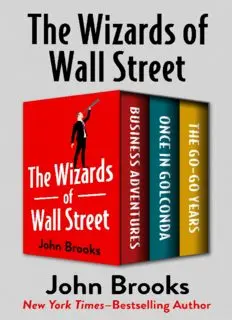
The Wizards of Wall Street: Business Adventures, Once in Golconda, and The Go-Go Years PDF
Preview The Wizards of Wall Street: Business Adventures, Once in Golconda, and The Go-Go Years
The Wizards of Wall Street Business Adventures, Once in Golconda, and The Go-Go Years John Brooks CONTENTS BUSINESS ADVENTURES 1 The Fluctuation 2 The Fate of the Edsel 3 The Federal Income Tax 4 A Reasonable Amount of Time 5 Xerox Xerox Xerox Xerox 6 Making the Customers Whole 7 The Impacted Philosophers 8 The Last Great Corner 9 A Second Sort of Life 10 Stockholder Season 11 One Free Bite 12 In Defense of Sterling ONCE IN GOLCONDA 1. Overture: The Outrage 2. Ticker Tyranny 3. The Almost Aristocracy 4. So Near the Apes 5. Things Fall Apart 6. Enter the White Knight 7. Gold Standard on the Booze 8. Ordeal in Washington 9. The White Knight Unhorsed 10. Rising Action 11. Catastrophe 12. Denouement THE GO-GO YEARS Chapter I: Climax Chapter II: Fair Exchange Chapter III: The Last Gatsby Chapter IV: Palmy Days and Low Rumblings Chapter V: Northern Exposure Chapter VI: The Birth of Go-Go Chapter VII: The Conglomerateurs Chapter VIII: The Enormous Back Room Chapter IX: Go-Go at High Noon Chapter X: Confrontation Chapter XI: Revelry Before Waterloo Chapter XII: The 1970 Crash Chapter XIII: Saving Graces Chapter XIV: The Go-Go Years About the Author Business Adventures Twelve Classic Tales from the World of Wall Street 1 The Fluctuation THE STOCK MARKET—the daytime adventure serial of the well-to-do—would not be the stock market if it did not have its ups and downs. Any board-room sitter with a taste for Wall Street lore has heard of the retort that J. P. Morgan the Elder is supposed to have made to a naïve acquaintance who had ventured to ask the great man what the market was going to do. “It will fluctuate,” replied Morgan dryly. And it has many other distinctive characteristics. Apart from the economic advantages and disadvantages of stock exchanges—the advantage that they provide a free flow of capital to finance industrial expansion, for instance, and the disadvantage that they provide an all too convenient way for the unlucky, the imprudent, and the gullible to lose their money—their development has created a whole pattern of social behavior, complete with customs, language, and predictable responses to given events. What is truly extraordinary is the speed with which this pattern emerged full blown following the establishment, in 1611, of the world’s first important stock exchange—a roofless courtyard in Amsterdam—and the degree to which it persists (with variations, it is true) on the New York Stock Exchange in the nineteen-sixties. Present-day stock trading in the United States—a bewilderingly vast enterprise, involving millions of miles of private telegraph wires, computers that can read and copy the Manhattan Telephone Directory in three minutes, and over twenty million stockholder participants—would seem to be a far cry from a handful of seventeenth-century Dutchmen haggling in the rain. But the field marks are much the same. The first stock exchange was, inadvertently, a laboratory in which new human reactions were revealed. By the same token, the New York Stock Exchange is also a sociological test tube, forever contributing to the human species’ self-understanding. The behavior of the pioneering Dutch stock traders is ably documented in a book entitled “Confusion of Confusions,” written by a plunger on the Amsterdam market named Joseph de la Vega; originally published in 1688, it was reprinted in English translation a few years ago by the Harvard Business School. As for the behavior of present-day American investors and brokers— whose traits, like those of all stock traders, are exaggerated in times of crisis—it may be clearly revealed through a consideration of their activities during the last week of May, 1962, a time when the stock market fluctuated in a startling way. On Monday, May 28th, the Dow-Jones average of thirty leading industrial stocks, which has been computed every trading day since 1897, dropped 34.95 points, or more than it had dropped on any other day except October 28, 1929, when the loss was 38.33 points. The volume of trading on May 28th was 9,350,000 shares—the seventh-largest one-day turnover in Stock Exchange history. On Tuesday, May 29th, after an alarming morning when most stocks sank far below their Monday-afternoon closing prices, the market suddenly changed direction, charged upward with astonishing vigor, and finished the day with a large, though not record-breaking, Dow-Jones gain of 27.03 points. Tuesday’s record, or near record, was in trading volume; the 14,750,000 shares that changed hands added up to the greatest one-day total ever except for October 29, 1929, when trading ran just over sixteen million shares. (Later in the sixties, ten, twelve, and even fourteen-million share days became commonplace; the 1929 volume record was finally broken on April 1st, 1968, and fresh records were set again and again in the next few months.) Then, on Thursday, May 31st, after a Wednesday holiday in observance of Memorial Day, the cycle was completed; on a volume of 10,710,000 shares, the fifth-greatest in history, the Dow-Jones average gained 9.40 points, leaving it slightly above the level where it had been before all the excitement began. The crisis ran its course in three days, but, needless to say, the postmortems took longer. One of de la Vega’s observations about the Amsterdam traders was that they were “very clever in inventing reasons” for a sudden rise or fall in stock prices, and the Wall Street pundits certainly needed all the cleverness they could muster to explain why, in the middle of an excellent business year, the market had suddenly taken its second-worst nose dive ever up to that moment. Beyond these explanations—among which President Kennedy’s April
